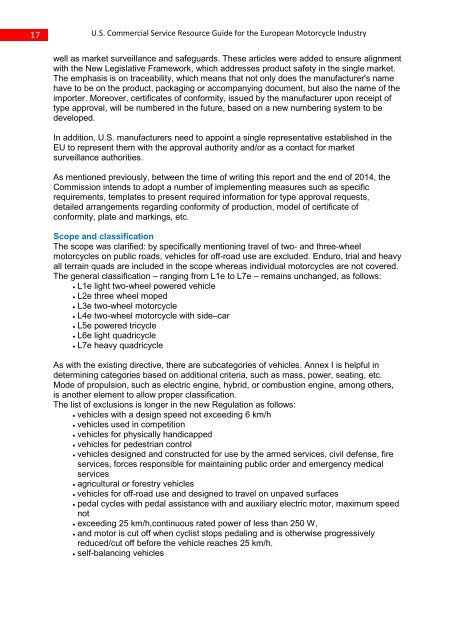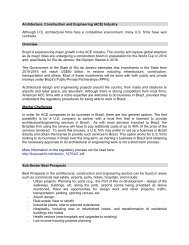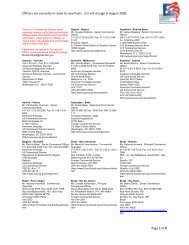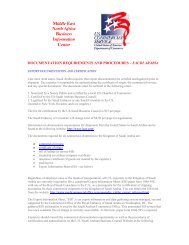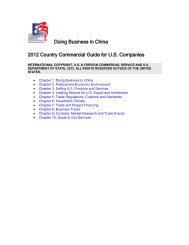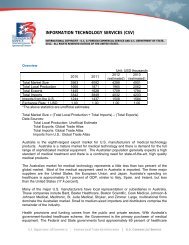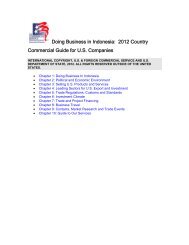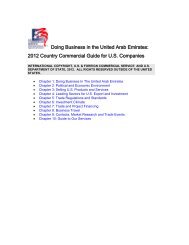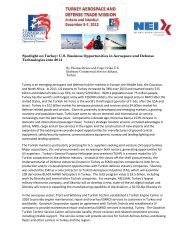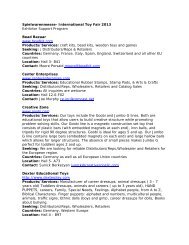“Motorcycles: European Market Briefs 2013-2014”. - Export.gov
“Motorcycles: European Market Briefs 2013-2014”. - Export.gov
“Motorcycles: European Market Briefs 2013-2014”. - Export.gov
You also want an ePaper? Increase the reach of your titles
YUMPU automatically turns print PDFs into web optimized ePapers that Google loves.
17<br />
U.S. Commercial Service Resource Guide for the <strong>European</strong> Motorcycle Industry<br />
well as market surveillance and safeguards. These articles were added to ensure alignment<br />
with the New Legislative Framework, which addresses product safety in the single market.<br />
The emphasis is on traceability, which means that not only does the manufacturer's name<br />
have to be on the product, packaging or accompanying document, but also the name of the<br />
importer. Moreover, certificates of conformity, issued by the manufacturer upon receipt of<br />
type approval, will be numbered in the future, based on a new numbering system to be<br />
developed.<br />
In addition, U.S. manufacturers need to appoint a single representative established in the<br />
EU to represent them with the approval authority and/or as a contact for market<br />
surveillance authorities.<br />
As mentioned previously, between the time of writing this report and the end of 2014, the<br />
Commission intends to adopt a number of implementing measures such as specific<br />
requirements, templates to present required information for type approval requests,<br />
detailed arrangements regarding conformity of production, model of certificate of<br />
conformity, plate and markings, etc.<br />
Scope and classification<br />
The scope was clarified: by specifically mentioning travel of two- and three-wheel<br />
motorcycles on public roads, vehicles for off-road use are excluded. Enduro, trial and heavy<br />
all terrain quads are included in the scope whereas individual motorcycles are not covered.<br />
The general classification – ranging from L1e to L7e – remains unchanged, as follows:<br />
• L1e light two-wheel powered vehicle<br />
• L2e three wheel moped<br />
• L3e two-wheel motorcycle<br />
• L4e two-wheel motorcycle with side–car<br />
• L5e powered tricycle<br />
• L6e light quadricycle<br />
• L7e heavy quadricycle<br />
As with the existing directive, there are subcategories of vehicles. Annex I is helpful in<br />
determining categories based on additional criteria, such as mass, power, seating, etc.<br />
Mode of propulsion, such as electric engine, hybrid, or combustion engine, among others,<br />
is another element to allow proper classification.<br />
The list of exclusions is longer in the new Regulation as follows:<br />
• vehicles with a design speed not exceeding 6 km/h<br />
• vehicles used in competition<br />
• vehicles for physically handicapped<br />
• vehicles for pedestrian control<br />
• vehicles designed and constructed for use by the armed services, civil defense, fire<br />
services, forces responsible for maintaining public order and emergency medical<br />
services<br />
• agricultural or forestry vehicles<br />
• vehicles for off-road use and designed to travel on unpaved surfaces<br />
• pedal cycles with pedal assistance with and auxiliary electric motor, maximum speed<br />
not<br />
• exceeding 25 km/h,continuous rated power of less than 250 W,<br />
• and motor is cut off when cyclist stops pedaling and is otherwise progressively<br />
reduced/cut off before the vehicle reaches 25 km/h.<br />
• self-balancing vehicles


